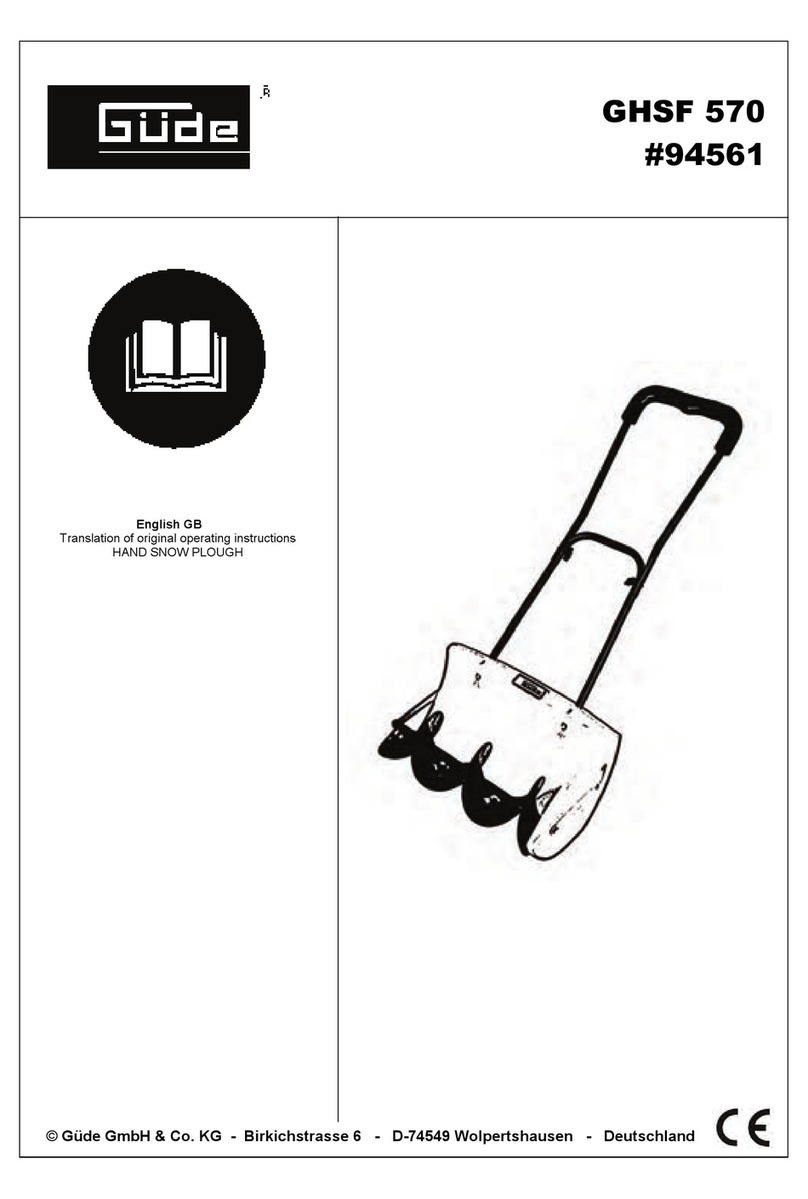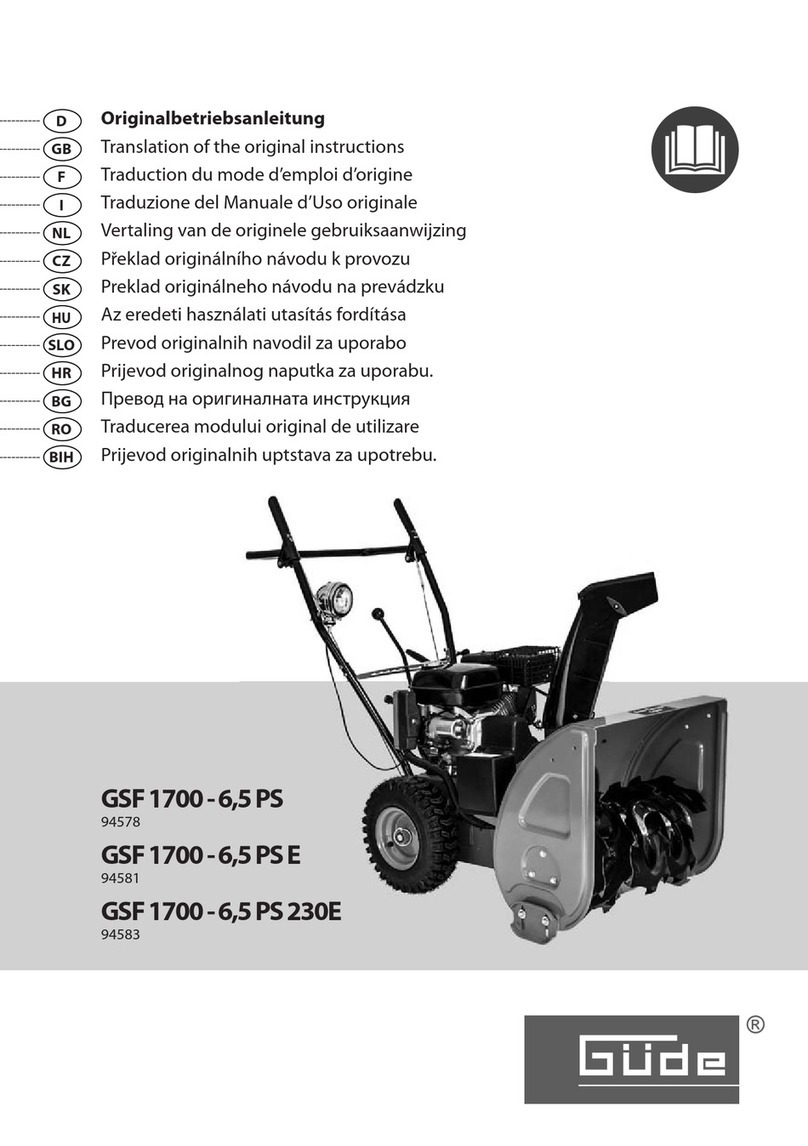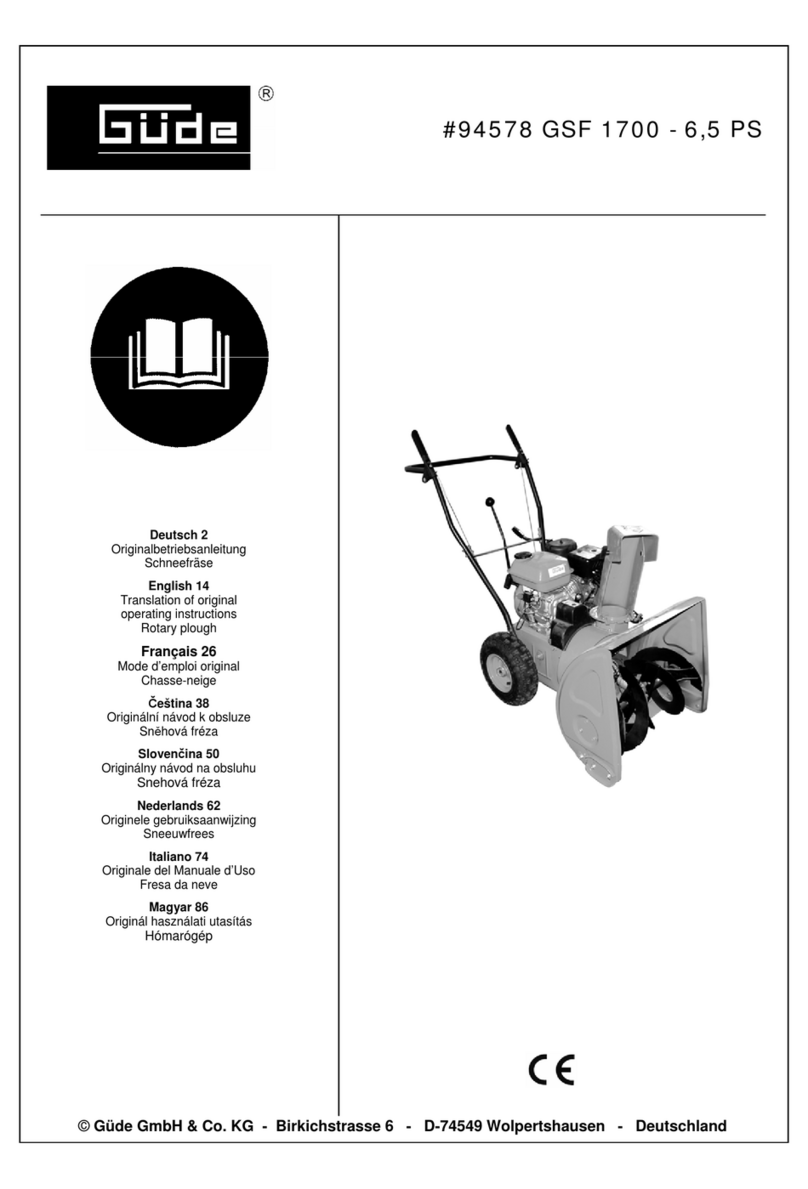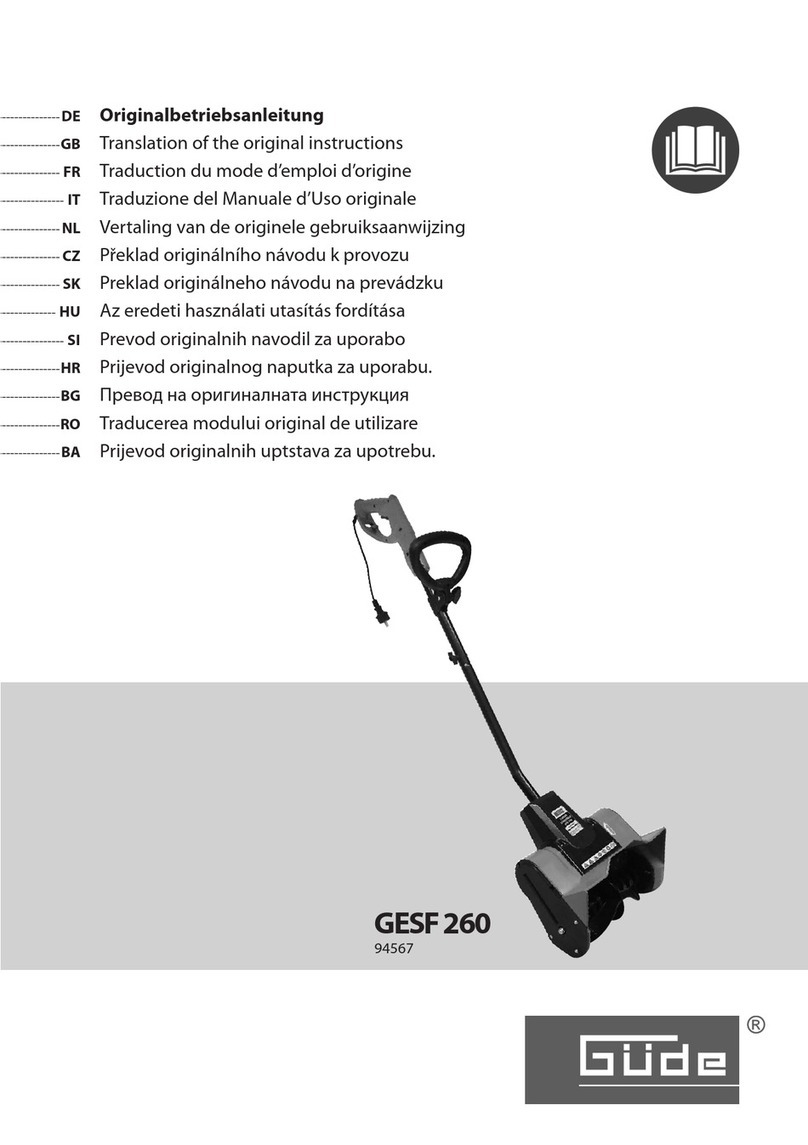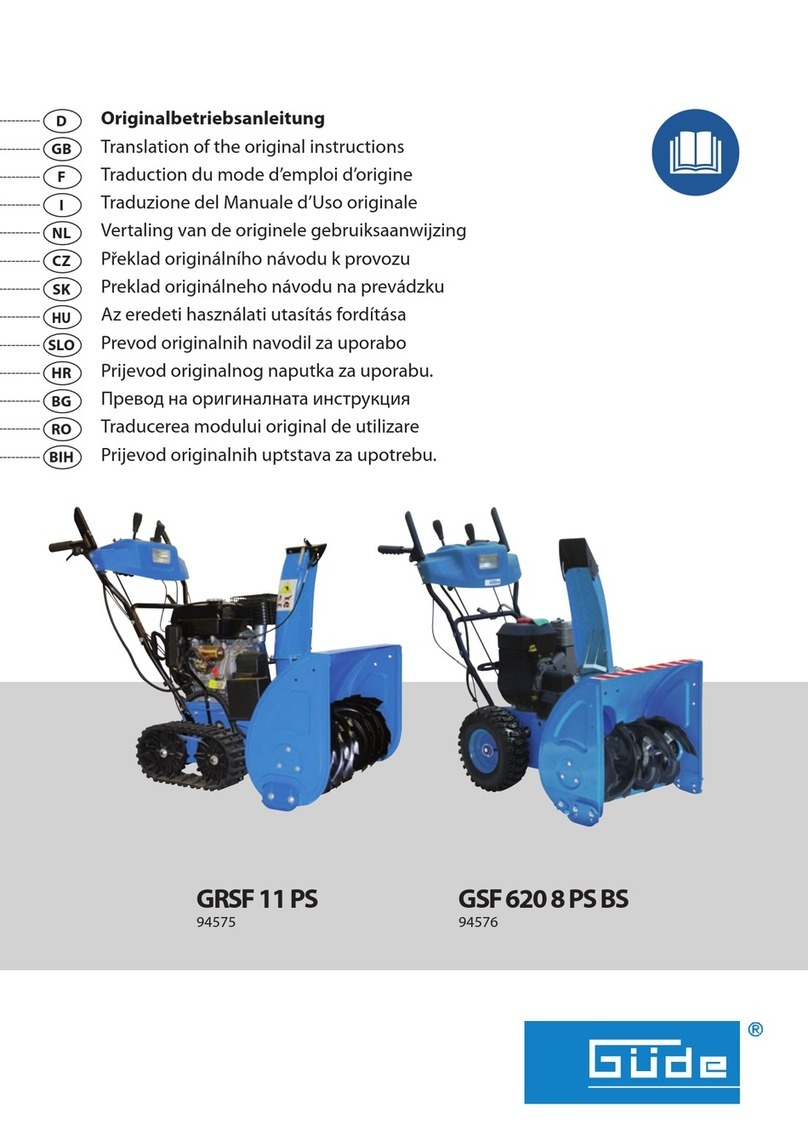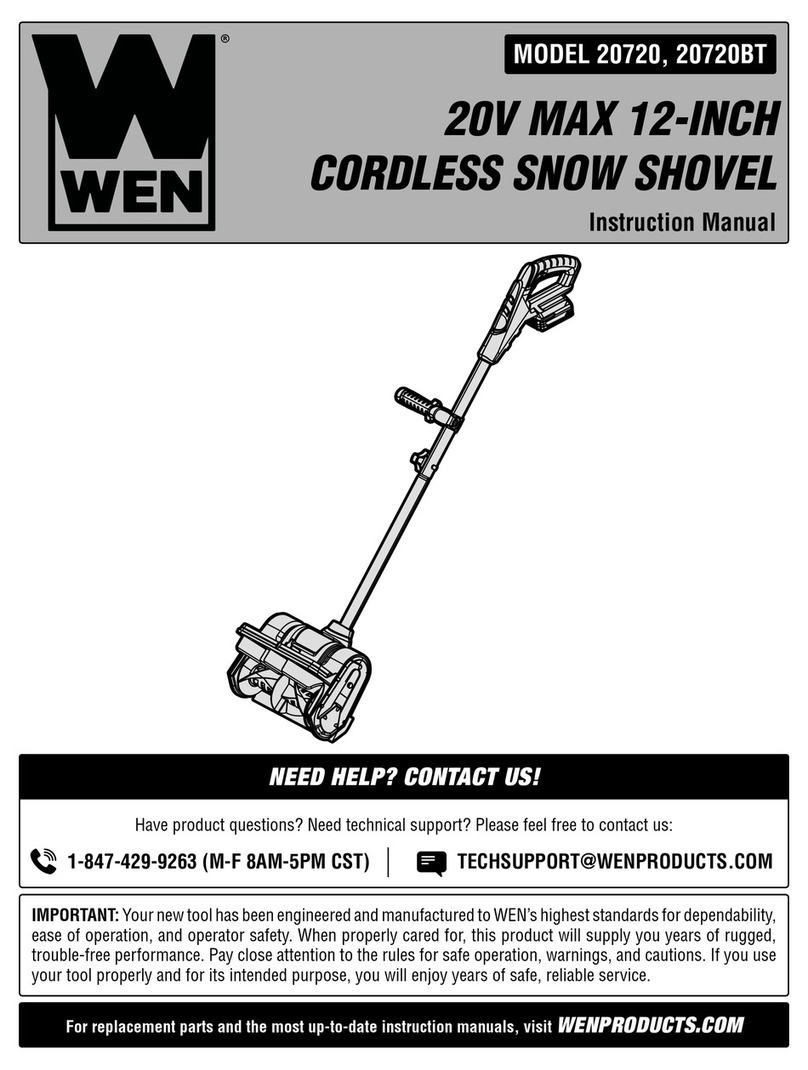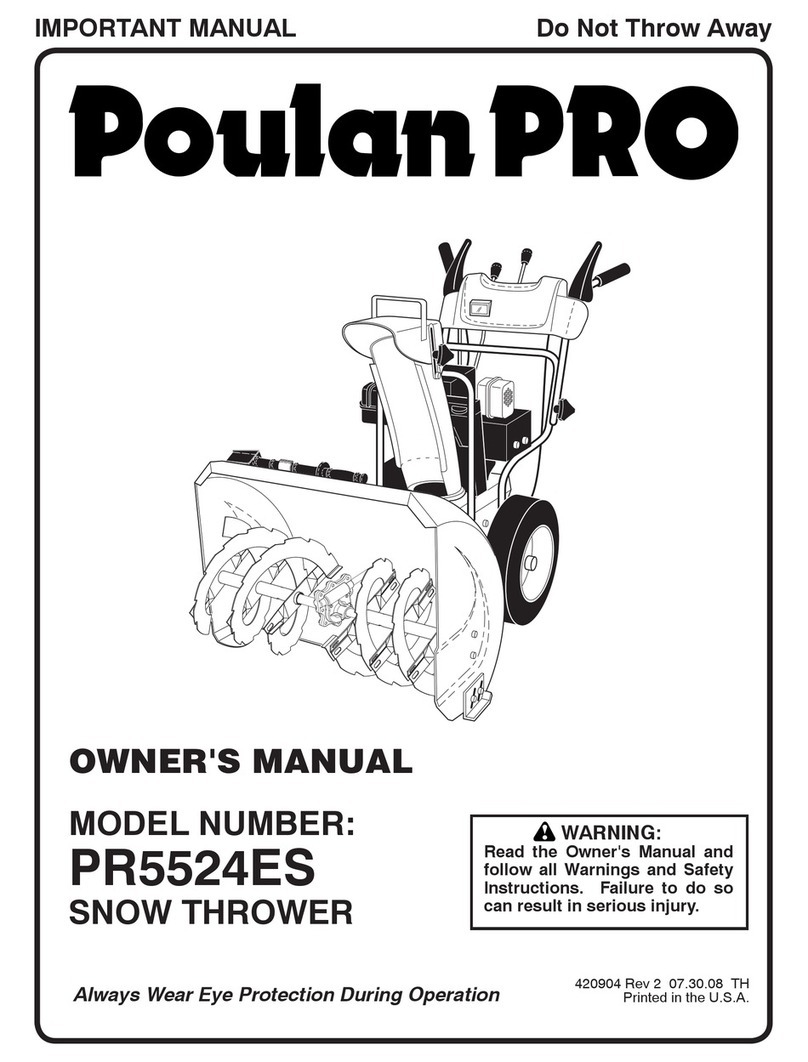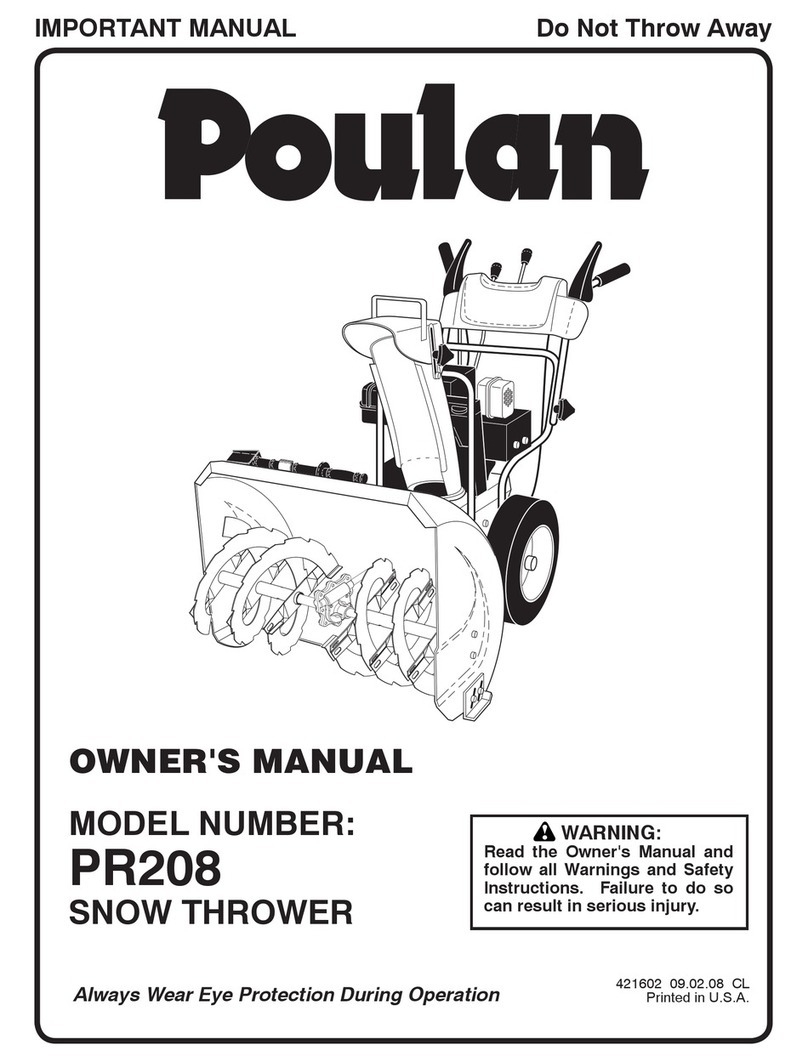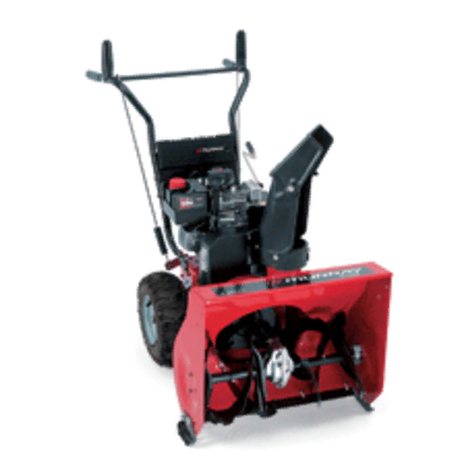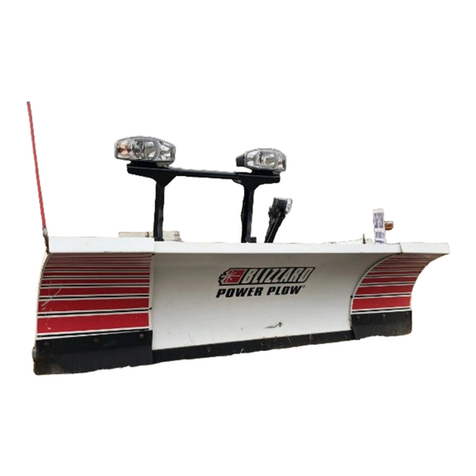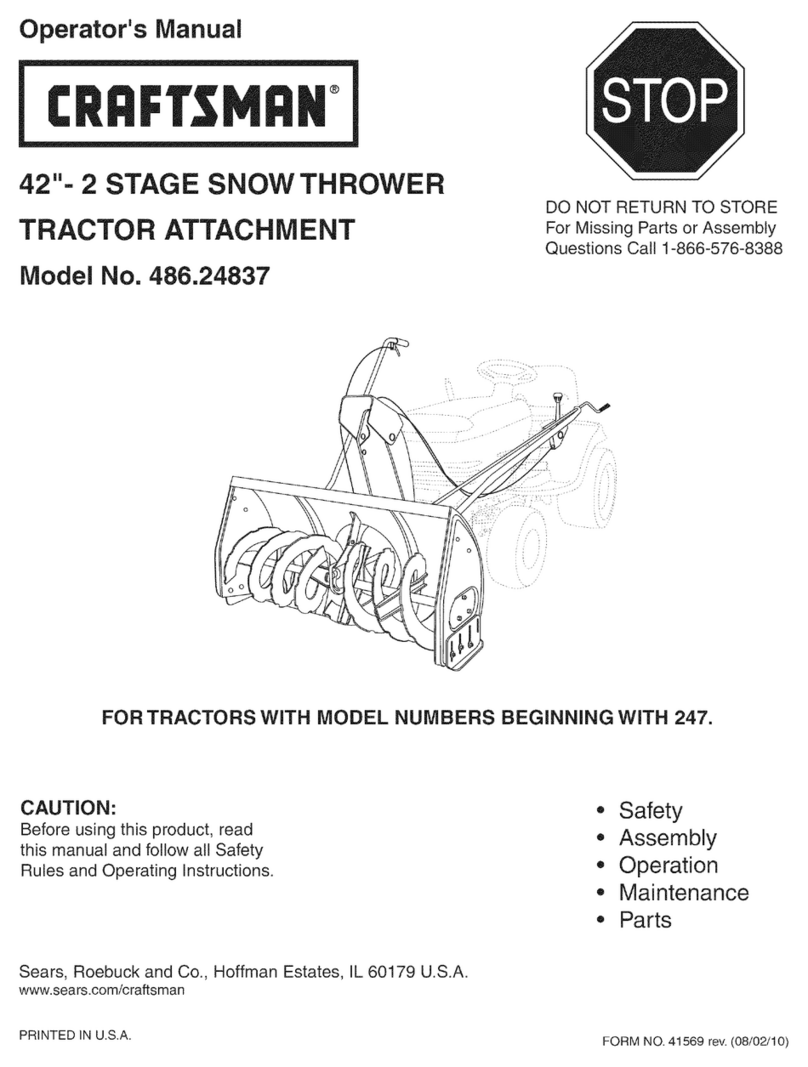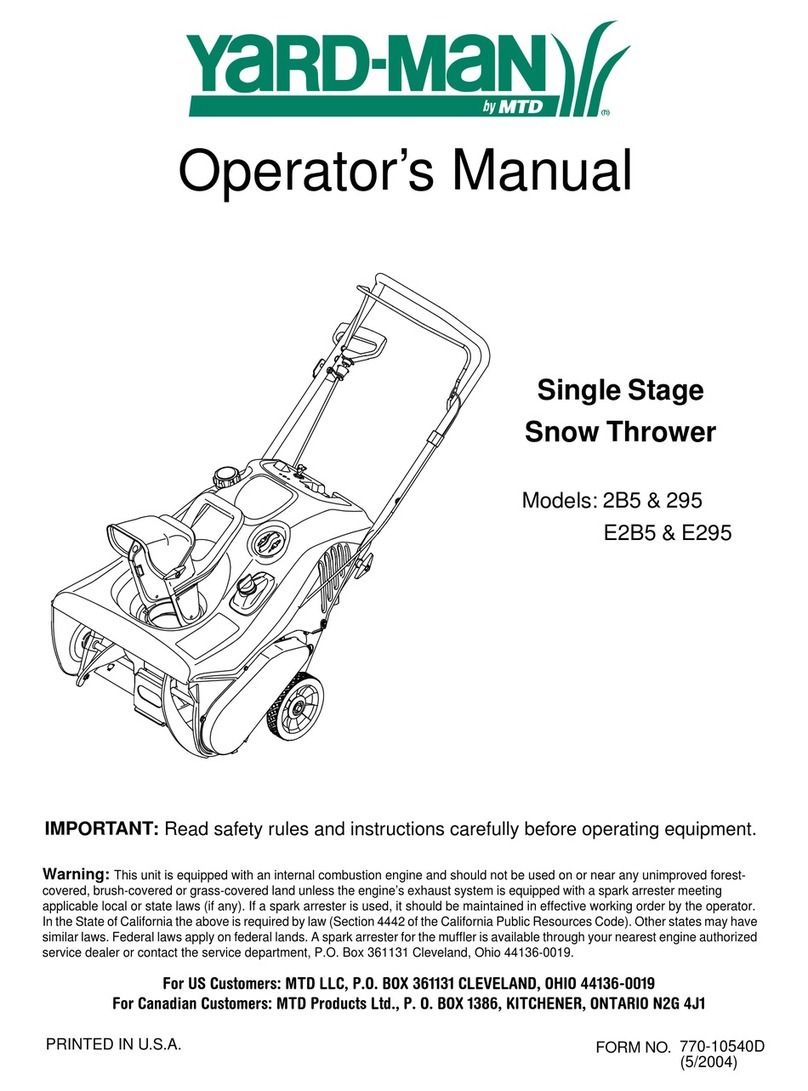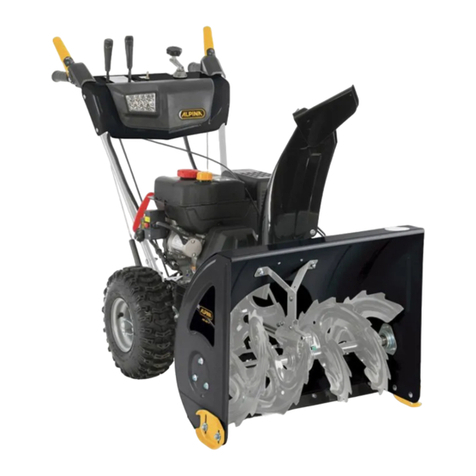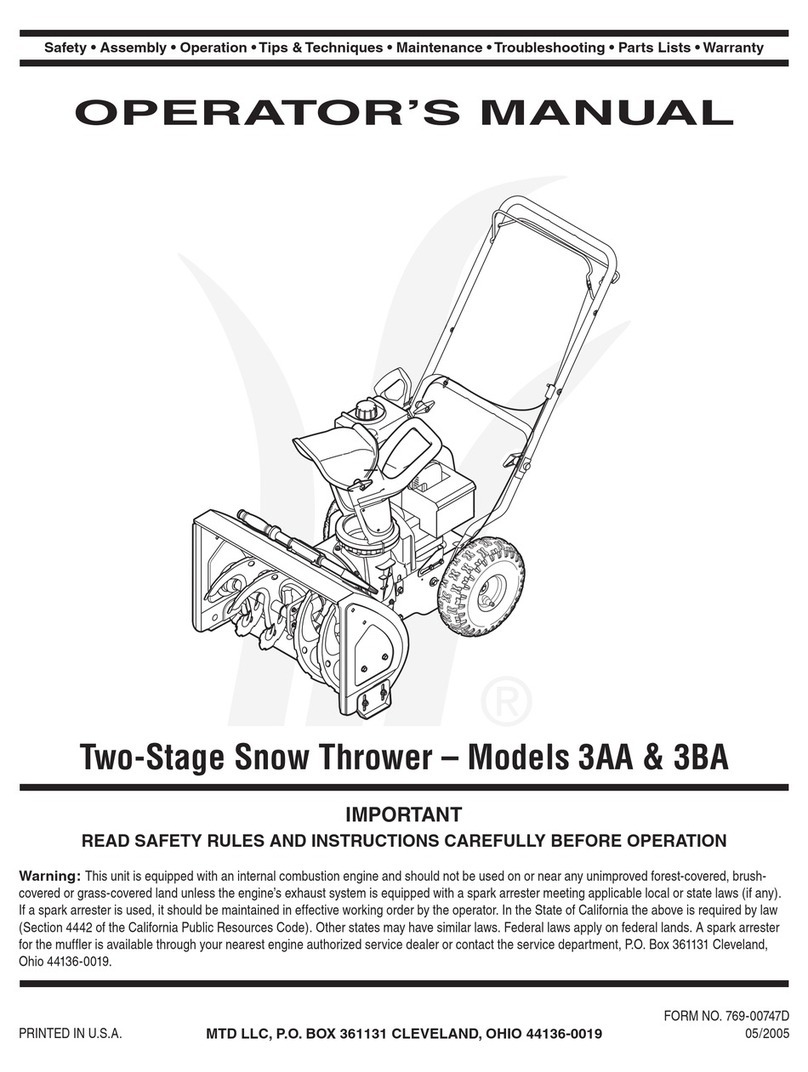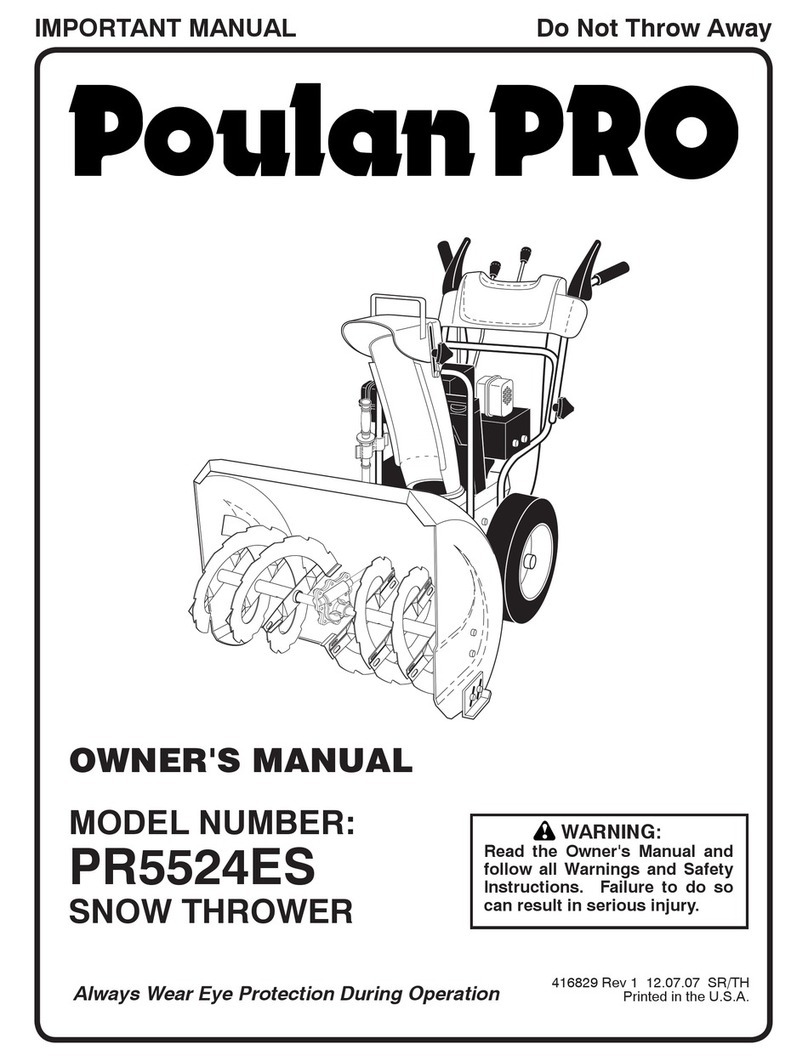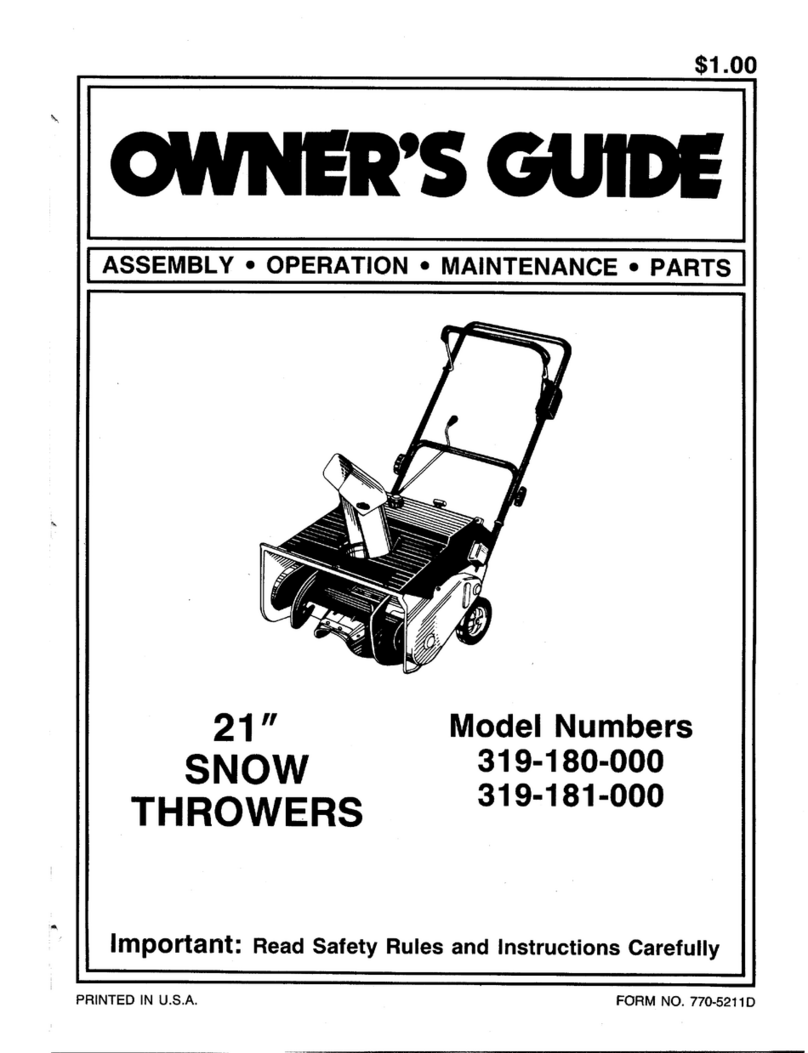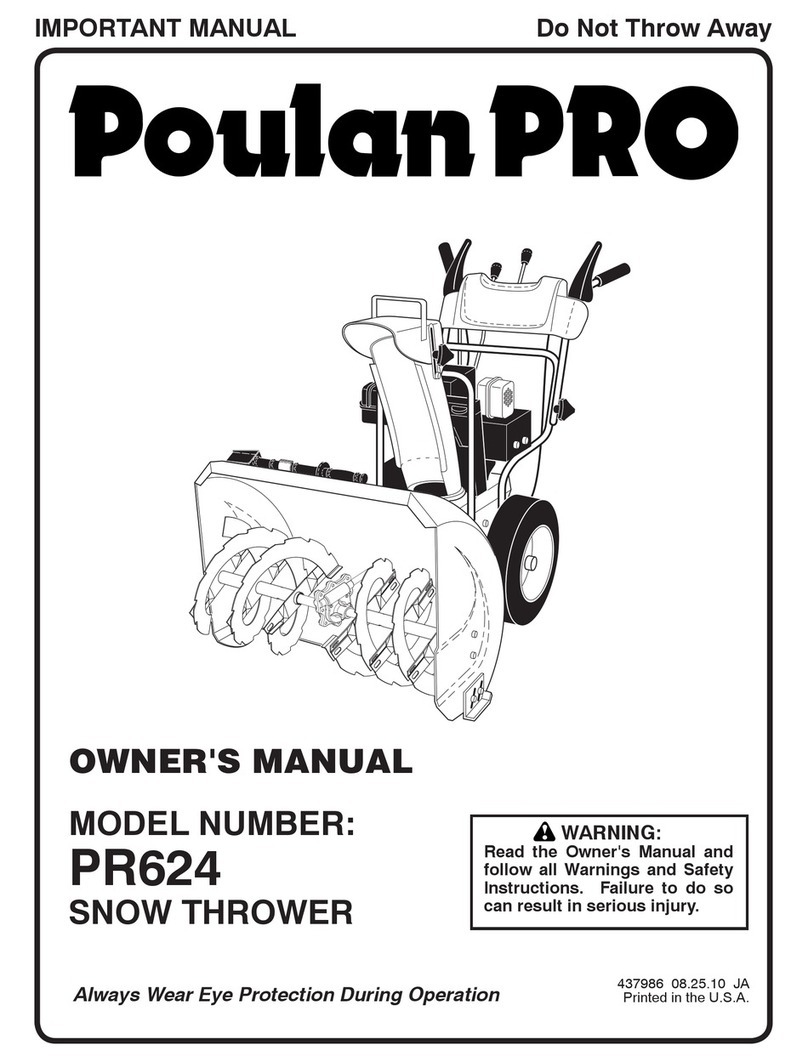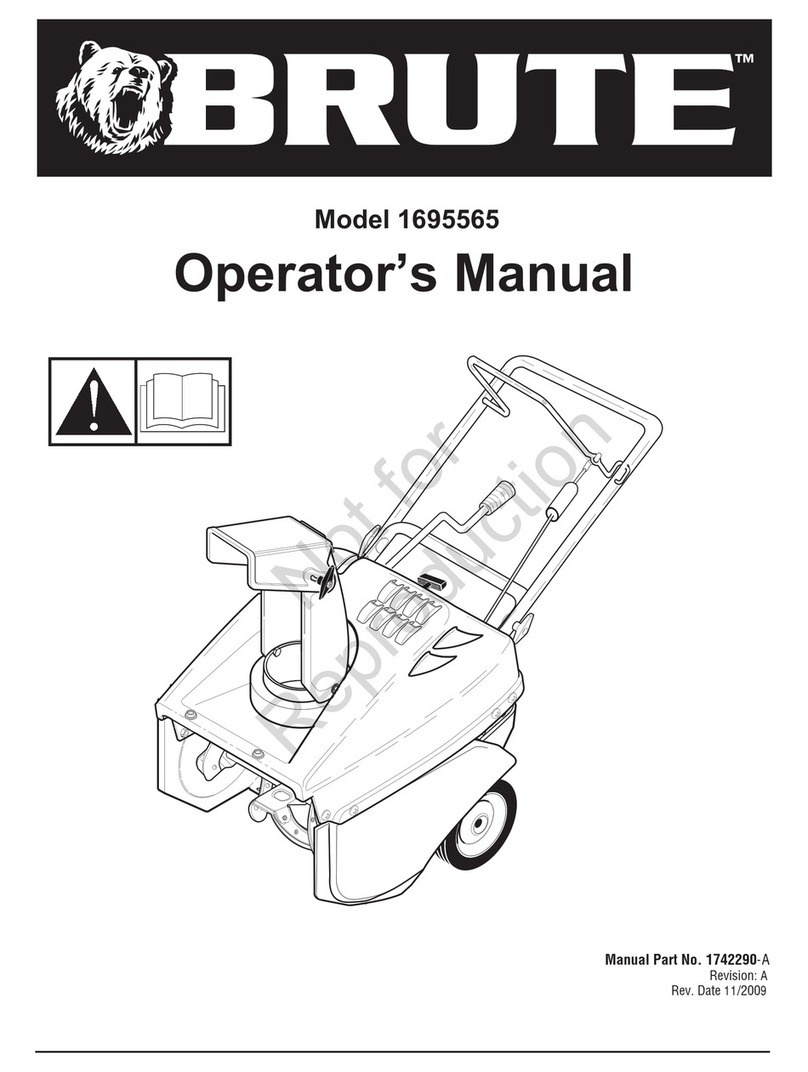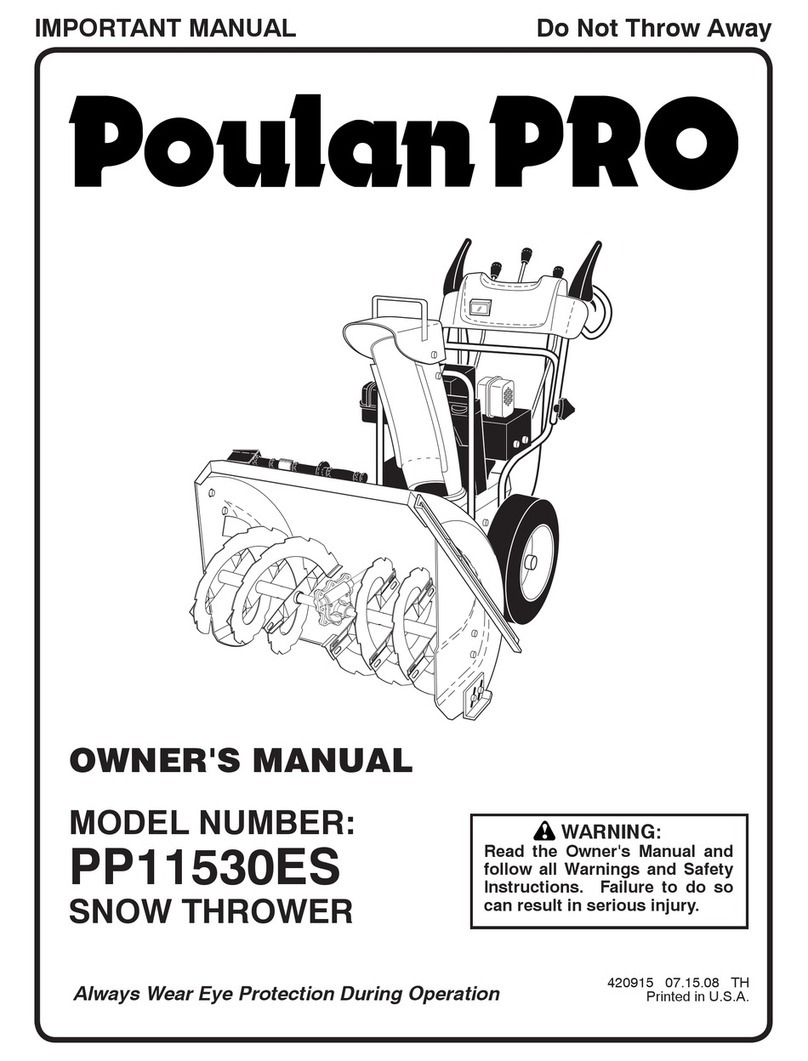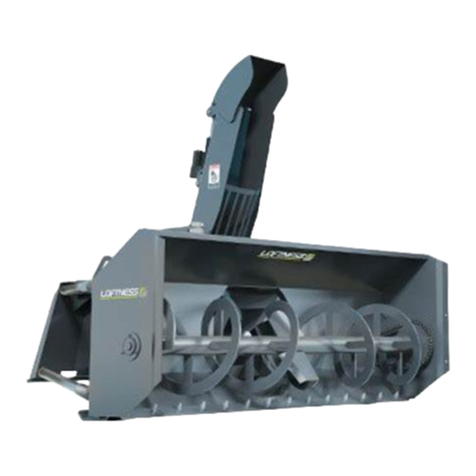Gude GESF 400 User manual

GESF 400
#94569
©Güde GmbH & Co. KG - Birkichstrasse 6 - D-74549 Wolpertshausen - Deutschland
English GB
Translation of original operating instructions
ELECTRIC SNOW BLOWER

1


Introduction
To enjoy your new electric snow blower as long as
possible, please read carefully the Operating Instructions
and the attached safety instructions before putting it into
operation. Further, we recommend keeping the Operating
Instructions in order to recall the product features in the
future.
To follow the continuous product development. we
reserve the right to make technical changes for any
further improvement.
This document represents the original Operating
Instructions.
Supply includes
Take the appliance out of the transport package and check
whether the supply includes the following parts:
•1 GESF 400 electric snow blower including 2-
point safety switch
•1 upper part of sliding post
•1 lower part of sliding post
•1 eject tube including adjusting rodding
•1 return flap including wing screws
•1 bag with small parts (cable clips, manual
wheels, cable pull strain relief equipment)
•1 wooden rod
•1 screwdriver
•1original Operating Instructions
If any part is missing or is damaged, please contact your
dealer.
Appliance in assembled state weighs 14.5 kg. Lift the
appliance off the transport package in two people if
necessary.
Appliance description
GESF 400 electric snow blower with a 2-point safety
switch with cable pull strain relief, flexible sliding post to
save space for storing. Stable plastic wheels. Eject tube
with continuous 2 x 90° rotation.
Appliance design (pic. 1)
1. 2-point safety switch
2. Cable clip
3. Upper part of sliding post
4. Manual wheel
5. Lower part of sliding post
6. Ejection tube
7. Rake
8. Wheel
9. Engine housing
10. Wooden rod
11. Cable pull strain relief
12. Adjusting rodding for eject tube
13. Wooden rod holder
14. Adjusting handle for ejection opening
Technical specifications of GESF 400 electric snow
blower
Voltage/frequency: 230V~50Hz
Protection type: IPX4
Protection class: II
Engine output: 1,600W (P1)
Engine revolutions: 2,800 a min-1
Cylinder Ø: 160 mm
Max. snow height: 160 mm
Max. snow removal width: 400 mm
Max. throw-away distance: 1m-4m
Noise: LWA 91dB *
Dimensions LxWxH (in mm): 1,000x450x920
Weight: 14.5kg
*Noise information
Measured values found out according to 2000/14/EG
(1.60m height, 1m distance) – measurement tolerance +-
3dB
General safety instructions
Please read carefully these Operating Instructions.
Familiarise with the control elements and appropriate
appliance using. Keep the Operating Instructions for future
reference.
Safe working
Keep the place of your work clean!
Mess in the place of your work may result in injuries.
Consider the environment influences
Do not expose the appliance to rain.
Do not use the appliance in a wet or moist environment.
Provide appropriate lighting.
Do not use the appliance near flammable liquids or gases.
Keep other persons in safe distance!
Do not let other persons, especially children, touch the
appliance and the cable. Keep them in a sufficient distance
from the place of your work.
Store the appliance properly!
An appliance that is not used should be stored in a dry,
locked place out of reach of children.
Do not overload the appliance!
Work in the specified output limits.
Use the right appliance!
Do not use the appliance for purposes for which it has not
been designed.
Look after your appliance!
Follow the maintenance regulations and instructions.
Check regularly the appliance cable and have it replaced
by an authorised professional if damaged.
Check regularly the extension cable and replace it if
damaged. Keep the handles dry, with no oil and grease.
Be careful!
Pay attention to what you are doing. Use common sense
when working. Do not use the appliance when you are
tired.
WARNING!
Use of any other accessories may pose a risk of injury.
Your appliance should be repaired by an electrician
only!
This appliance meets the appropriate safety provisions.
Repairs may only be executed by an electrician and
original spare parts must be used, otherwise the user may
face a risk of injury.
Appliance-specific safety instructions
This appliance has exclusively been designed to be used
•as a snow blower for removing snow from paved
roads and surfaces around house and in the
garden.
13

•in accordance with the descriptions and safety
instructions mentioned in these Operating
Instructions.
Any other use is in conflict with the designation!
Appliance use in conflict with the designation or any
changes made to the appliance shall make the
manufacturer's warranty void.
The user warrants for damages caused to third parties and
their property by using the appliance.
Being the user of the appliance, you should carefully read
these Operating Instructions before the appliance is used
for the first time. Proceed in accordance with these
instructions and keep them for future reference or if the
appliance owner is changed.
Persons using the appliance must not be under the
influence of addictive drugs such as alcohol, drugs or
pharmaceuticals.
Young persons under 16 years of age must not handle the
appliance (local provisions may stipulate the user's
minimum age).
Persons, especially children, and pets should be kept
outside the dangerous area.
Never use the appliance inside rooms; to be used
outdoors only. Covered and high wall-enclosed paths may
only be worked on if safe operation can be provided. Pay
especially attention to windows and persons in the
immediate vicinity to prevent material and personal
damage.
Do not directly aim the appliance at persons.
Do not use the snow blower near glass, cars, windows,
etc. without setting the right snow throw-away angle.
Wear gloves, protective glasses, closefitting winter clothes
and solid shoes with a rough sole when working and
providing maintenance.
Never put parts of your body and clothes near rotating
parts.
Use the appliance only when appropriate lighting is
provided. The appliance and handles should always be
held tightly. Never run with the appliance.
Use the appliance only for removing light and loose snow
(fresh snow) up to the maximum snow height of app. 10
cm.
Icy snow and ice must not be removed by the snow
blower.
Put the appliance out of operation and store it in a closed
room only after the engine has cooled down.
Use the appliance only when it is in a perfect state
specified by the manufacturer.
Use only original spare parts of the manufacturer or spare
parts of other manufacturers approved by the
manufacturer.
Have the appliance repaired by an authorised shop only.
Do not adjust the appliance when the engine is running
(except for settings directly recommended by the
manufacturer).
The safety distance from the rotating tool given by the
sliding posts always needs to be kept.
Switch off the engine before running on surfaces such as
footpaths and court entrances on which you do not wish to
remove the snow. The appliance should always be used
when in a perfect and safe state.
Check the ground on which the appliance is going to be
used and remove any items that might be caught or thrown
off by the appliance.
Possible damage to the appliance: When the appliance
hits a foreign item (e.g. stones) or when there are
abnormal vibrations the appliance must be switched off
and checked for any damage. Have any detected damage
removed and resume working with the appliance only after
the damage has been removed.
The appliance should only be used when in a perfect state.
Carry out a visual inspection before switching the
appliance on. Check especially the safety equipment,
electrical control elements, power lines and screw
couplings for any damage and if they are tightened
appropriately. Replace any damaged parts before the
appliance is put into operation if necessary.
Snow should be removed only after adjusting the snow
blower to the outdoor temperature when there are extreme
temperature differences. Immediate snow removing could
lead to premature wear of the drive shaft and other
extensions such as the rubber flap.
Work slowly and carefully, especially when changing the
direction. On slopes, guide the appliance up and down, not
crossways. Watch out for obstacles; do not work near
steep slopes. Do not use the appliance on slopes with
inclination of more than 20%.
Remove the snow immediately after it has fallen down; the
bottom layer gets icy later and makes removing more
difficult.
Snow should be removed in the wind direction if possible.
Remove the snow in a way to ensure the snow removal
lanes slightly overlap each other.
The appliance must not be used by persons (and children)
with limited physical, sensory and mental abilities or
persons lacking appropriate experience and knowledge
even if working under the supervision or trained on using
the appliance by a safety engineer before putting the
appliance into operation.
Children need to be watched to make sure they do not
play with the appliance.
Electrical safety
Feeder cables (max. 50 m) meeting outdoor use
requirements, e.g. H07RN-F 3x1.5 mm² within –25°C
H07BQ-F 3x1.5 mm² within –40°C should only be used.
Joints of feeder cables must be watertight and made of
rubber or coated with rubber.
Before using the appliance, check whether the feeder
cables are not damaged, broken or entangled. Switch the
appliance off and unplug it. Feeder cables in a perfect
state should be used only.
Switch the engine off and unplug it if you are not working
with the appliance or when leaving the appliance or
adjusting, maintaining or repairing it.
Use a safety switch against stray current with max. 30 mA
actuating current for your socket.
If the cable gets broken when working with the appliance,
there is a risk of life and injury. Slowly, making small steps,
get away from the appliance. Unplug the appliance. Make
sure the feeder cable never gets to the working area when
the appliance is being operated.
A feeder cable that is damaged may only be replaced by
the manufacturer, its customer service or similar
authorised staff to prevent any risk.
Warning! This appliance generates an electromagnetic
field when being operated. Under certain circumstances,
this field may damage active and passive medical
implants. To minimise the risk of serious or fatal injury,
persons with medical implants are recommended to
consult their doctor and medical implant manufacturer
before operating the appliance.
When turning the appliance, you might tumble over the
feeder cable and get hurt. The cable should always be
guided in a way to make sure it can never get to the area
you are walking or working in.
Guide the appliance only at a step pace.
Work under appropriate lighting only.
Work slowly and carefully, especially on uneven and earth
roads or when reversing.
Training
Read carefully the operating and maintenance instructions.
Familiarise thoroughly with the controls and proper use of
the appliance. You need to know how the appliance works
and how controls can immediately be switched off.
Never let children work with the appliance. Never let adults
work with the appliance unless they have been properly
trained.
Keep all persons, especially small children, and pets out of
reach of the place of your work.
14

Being careful prevents slipping or falling, especially when
reversing.
Safety operation instructions
Do not put your hands and legs near the rotating parts.
Keep a safe distance from the eject hole.
Be extremely careful when running over or removing snow
off brash entrances, footpaths and paths. Be prepared for
unexpected risks or moving vehicles.
When you hit a foreign item, switch the engine off,
disconnect the cable from the spark plug and check
thoroughly the snow blower for any damage and remove it
if necessary – the snow blower can be put into operation
again and worked with now.
If the appliance starts abnormally vibrating, switch the
engine off and search for the cause immediately.
Generally, vibrations are a warning against operating
failure.
Switch the engine off every time you stop operating the
appliance, clean the working screw/rotor can/eject tube
and when executing repairs, adjusting and inspecting the
appliance.
When cleaning, repairing and checking the appliance,
make sure that the working screw/rotor and all moving
parts are stopped. Disconnect the spark plug cable and
secure it in a way to ensure it cannot touch the connector
and cause unwanted engine starting.
Pull the cable out of electric motors.
Do not remove snow across slopes. Be extremely careful
when changing movement direction on slopes. Never try to
remove snow on steep slopes.
Never use the snow blower when guards, sheets and other
protection components are not installed properly.
Never use the snow blower near glass surfaces, cars,
windows, pits, etc.; set the eject tube angle properly.
Children and pets must be in a sufficient distance from the
appliance.
Do not overload the appliance; do not try to remove snow
too quickly.
Never use the appliance at a high travelling speed on a
slippery surface. Be careful when reversing.
Never aim the eject tube at bystanders. Do not allow
anyone to stand before the appliance.
Disconnect the working screw/rotor drive when the snow
blower is to be transported or when not being used.
Use only extensions and accessories approved by the
snow blower manufacturer (e.g. wheel weights,
counterweight, cabins, etc.).
The snow blower must only be used when appropriate
visibility or good lighting is provided. Stand fast on the
ground and hold the handle tight by hands at all times.
Walk, never run.
Do not allow anybody to stand on the appliance.
Use the snow blower only when appropriate visibility or
good lighting is provided.
Take all safety measures when leaving the appliance
unattended.
Stop the output shaft drive, lower the extensions, shift into
neutral, apply the parking brake, switch off the engine and
pull out the key.
Caution!
At less powerful networks there might be short voltage
fluctuations when the appliance is switched on. This may
influence the function of other appliances, e.g. there might
be light intensity fluctuations. Where there is network
impendance of Zmax < 0.997 Ω, these negative influences
need not be expected (more information can be obtained
from your local energy supplier if necessary).
Use as designated
The product you have bought (electric snow blower) has
exclusively been designed for the following range of use:
Proper removal of snow from private footpaths, entrances
and parking places unless they fall within the general road
traffic regulation (e.g. public footpaths or entrances; for
that, permit specific for the given country needs to be
requested from appropriate authorities if necessary).
Only fresh snow is used as the processed material.
Any other use is in conflict with the designation. The
manufacturer is not liable for any indirect damages and
injuries. Please be sure to know that our appliances have
not been designed for industrial use.
Installation
Caution! The appliance needs to be switched off and
unplugged before maintenance, cleaning and installation.
The same must be done if the feeder cable is damaged,
incised or entangled.
Respect the system voltage: current source voltage must
correspond to the details on the appliance type label.
An extension cable with a too small wire cross section
significantly reduces the appliance performance. For
cables within a length of 25 m at least 3 x 1.5mm²; for
cables of more than 25 m of length at least 2.5mm².
Caution! Extension cables not approved must not be used.
The extension cable, plug and clutch must be watertight
and approved for outdoor use.
Cable communications must be dry and must not lie on the
ground.
If a cable drum is used, it needs to be unwound.
Some parts of the snow blower are not installed when
being transported to the buyer.
Screws, manual wheels, cable clips and screwdriver can
be found in a separate plastic bag. Installation is simple if
instructions below are followed.
Eject tube
Take the appliance and all components out of the box.
Remove all the 4 screws on the front cover and the front
part (pic. 2). Now insert the eject tube to the front hole of
the cover. Then, using the 4 screws, mount the front part
to the cover and tighten the screws in a way to make sure
the eject tube is in a safe position that can be freely turned
by 180°. Finally, using the 2 supplied wing screws, mount
the upper return flap to the eject tube.
Lower upper of the sliding post
Pull the other end of the adjusting rodding (coming from
the eject tube) on the lower part of the sliding post and
then push the lower part of the sliding post down to both
cover holes (pic. 3). Make sure that both supporting
clamps clicked into the bottom end of the lower part of the
sliding post on the cover.
Upper part of the sliding post
Bring the cable pull strain relief equipment for the
extension cable to the upper part of the sliding post (pic.
4). Make sure the cable pull strain relief equipment does
not later get in contact with the 2-point safety switch to
prevent undesirable blocking (pic. 11). Now connect both
post halves and screw them to each other using the
supplied screws with manual wheels. The adjusting
rodding is used to change the eject tube direction.
Mount the 2-point safety switch to the upper part of the
sliding post, using two screws, to the appropriate hole
unless the switch is already assembled to the upper part of
the sliding post (pic. 6).
15

Adjusting rodding for ejection opening
Put the eye bolt on the rodding (pic. 8-1).
Hook the rodding end on the pivot point and turn the
rodding to fix it to the post (pic. 8-2).
Secure the eye bolt on the bottom post with the wing nut
(pic. 9-1).
Wooden rod (pic. 10)
The wooden rod is primarily used to release the
accumulated and stuck ice remains in the eject tube.
Before removing the stuck material, the snow blower must
always be switched off and unplugged. Otherwise there is
a risk of amputation and getting jammed!
Before you start working
Check carefully the entire area you are going to work in
and remove all items such as mats, sledges, boards,
cables and other foreign items. Before starting the engine,
declutch the appliance and shift into neutral.
Wear appropriate winter clothes when working with the
appliance.
Wear shoes that adhere well to the slippery surface.
Use a grounded socket with three wires for all units with
electric driving engines or electric starters.
Set the working screw height so that it does not touch the
surface with rubble or road metal.
Never try to adjust the appliance when running (except
when it has been specifically recommended by the
manufacturer).
Let the engine and appliance adapt to the outside
temperature and then start removing snow.
There is a risk of items being thrown off at eyes when
working with power appliances.
Protective glasses or a shield should always be used when
operating, adjusting or repairing the appliance.
Operation
Switch-on and starting
To prevent unintentional appliance switch-on, the 2-point
safety switch is fitted with a safety pressure switch (pic.
11-A). This switch must be pressed before the switch lever
(pic. 11-B) is pressed. If the switch lever is released, the
safety pressure switch gets back to its starting position and
the engine stops immediately. Make sure the extension
cable is not within rake's reach and is properly connected
with the switch (pic. 5, 11).
Marking
Product safety:
Product corresponds to
appropriate EU standards Protection class II
Prohibitions:
No pulling the cable! Protect against rain and
moisture!
Using indoor prohibited Do not touch inside the
appliance
Make sure the processed
material does not contain
any metal items, stones,
bottles, cans or other foreign
items.
Warning:
Warning/caution Warning against dangerous
voltage
Warning against thrown-off
items
Warning! Rotating
appliance poses a risk of
injury!
Caution, risk of drawing-in Keep bystanders in safe
distance from the appliance
(at least 5m)
Risk due to rotating knife of
the blower. Never put hands
and legs in the hole.
Warning against thrown-off
items
Never aim the eject tube at
living creatures, cars and
buildings.
Commands:
General command mark
Read carefully the
Operating Instructions.
Familiarise thoroughly with
the appliance use
principles.
Use protective glasses Use protective gloves
Use safety shoes
Environment protection:
Dispose waste professionally
so as not to harm the
environment.
Packing cardboard material
may be delivered to
collecting centres for
recycling.
16

Faulty and/or disposed electric
or electronic appliances must
be taken to appropriate
collection centres.
Package:
Protect against moisture This side up
Interseroh-Recycling
Technical specifications:
Connection Weight
IPX4
Engine output Protection type
Revolutions Noise
Max. snow height Max. snow removal width
Max. throw-away distance
EU DECLARATION OF CONFORMITY
We,
Güde GmbH & Co. KG
Birkichstrasse 6
D-74549 Wolpertshausen
Germany
herewith declare that the following appliance complies with
the appropriate basic safety and health requirements of
the EU Directives based on its design and type, as brought
into circulation by us.
In case of alternation of the machine, not agreed
upon by us, this declaration will lose its validity.
Machine description:
GESF 400 ELECTRIC SNOW BLOWER
Article No.
#94569
Applicable EU Directives:
2006/42/ EG
2004/108 EG
2000/14 EG
2002/95 EG
Applicable harmonised standards:
EN 60335-1:2002+A1+A11+A12+A2+A13
ISO 8437:1989+A1
ZEK 01.2-08/12.08
EN 62233:2008
EN 55014-1:2006+A1
EN 55014-2:1997+A1+A2
EN 61000-3-2:2006+A1+A2
EN 61000-3-3:2008
Date/authorised signature: 15 May, 2012
Title of signatory: Managing Director
Mr Arnold
Technical documentation: J. Bürkle FBL; QS
Guarantee
The guarantee exclusively applies to material or
manufacturing defects. The original proof of purchase with
the purchase date must be submitted when lodging a claim
in the guarantee period. The guarantee does not include
any unauthorised use, e.g. appliance overloading, violent
use, damage by a third party or foreign item. The failure to
follow the Operating Instructions and assembly instructions
and common wear and tear are not covered by the
guarantee either.
Residual risks and protective measures
Electrical residual risks:
Threat Description Protective measure(s)
Direct
electrical
contact
Cable could be
broken by the
worm or wound
and damaged.
Electric connection with FI
must only be worked on.
Mechanical residual risks:
Threat Description Protective measure(s)
Getting
caught,
winding-up
Worm may
catch and draw
in cords, wires
or parts of
clothes.
Rotating worm
could catch the
feeder cable
and wind or
break it.
Remove any foreign items
from the ground; keep a
distance from fences and
wear closefitting clothes.
A sufficient distance from the
cable on the ground must
always be kept when working
and it must not be run over.
Other risks
Threat Description Protective measure(s)
Thrown-off
items or
spraying
liquids
Thrown-off
stones, earth,
etc. may cause
injury.
Make sure the eject tube is
never aimed at persons, pets
or items. Check the ground
on which you are using the
appliance and remove any
items that may get caught by
the appliance.
17

Loss of
stability Ice surfaces
under the snow
layer and the
surface being
cleaned.
Ensure the surface is
adequate (gravelled).
Slipping, trip
or fall of
persons
You may
stumble when
reversing and
your legs could
be caught by
the appliance.
Ensure the surface is
adequate.
Neglect of ergonomic principles
Threat Description Protective measure(s)
Negligent
use of
personal
protective
aids
Thrown-off
stones, earth,
etc. may injure
your eyes and
hands. Wide
clothes can get
caught by the
appliance.
Inappropriate
shoes may lead
to slipping on
an icy surface.
Wear protective glasses,
gloves, closefitting winter
clothes and solid shoes with a
rough sole when working.
Insufficient
local lighting Insufficient
lighting/inappro
priate light
conditions pose
a high safety
risk.
Sufficient lighting/good light
conditions must always be
provided for working with the
appliance.
Behaviour in case of emergency
Provide necessary first aid treatment corresponding to the
injury nature and seek qualified medical help as soon as
possible.
Protect the injured person from other injuries and calm
him/her down.
First aid kit must always be available in the place of
your work in case of accident in accordance with DIN
13164. Material taken out of the first aid kit needs to be
supplemented right away.
If help is needed,
please provide the following details:
1. Place of accident
2. Accident nature
3. Number of injured persons
4. Injury type
Disposal
The disposal instructions are based on icons placed on the
appliance or its package. The description of the meanings
can be found in the “Marking” chapter.
Transport package disposal
The package protects the appliance against damage
during transport. Packing materials are usually chosen
depending on their environmental friendliness and disposal
method and can therefore be recycled.
Returning the package to material circulation saves raw
materials and reduces waste disposal costs.
Parts of packages (e.g. foils, styropor) can be dangerous
to children. Risk of suffocation!
Keep parts of packages away from children and dispose
them as soon as possible
Operating staff requirements
The operator must carefully read the Operating
Instructions before using the appliance.
Qualification
No special qualification is necessary for using the
appliance apart from detailed instruction by a qualified
person.
Minimum age
The appliance may only be operated by persons over 16
years of age. An exception includes youngsters operating
the appliance within their professional education to
achieve necessary skills under teacher's supervision.
Training
Using the appliance only requires appropriate instructions
by a professional or reading the Operating Instructions. No
special training necessary.
Servicing
Do you have any technical questions? A claim? Do you
need spare parts or the Operating Instructions?
You will be helped quickly and without needless
bureaucracy at our webpage www.guede.com in the
Service part. Please help us be able to assist you. To be
able to identify your appliance when claimed, we need to
know its serial No., order No. and year of production. All
these details can be found on the type label. Enter the
details below for future reference.
Serial No.
Order No.
Year of production:
Tel.: +49 (0) 79 04 / 700-360
Fax: +49 (0) 79 04 / 700-51999
Maintenance and storing
To provide protection against injury, do the following
before maintenance:
•Switch off the engine.
•Wait until all rotating parts fully stop.
•Unplug the appliance.
•Let the engine cool down (app. 30 minutes).
To provide protection against injury, do the following
before cleaning:
•Switch off the engine.
•Wait until all rotating parts fully stop.
•Unplug the appliance.
•Let the engine cool down (app. 30 minutes).
•Do not spray water on the appliance as electrical
components could get damaged.
If the appliance is not used for more than one month,
e.g. after the season is over:
•Clean the appliance.
•To protect all metal parts against corrosion, wipe
them with an oil-soaked cloth or spray with oil in
a spray gun.
•Store the appliance in a clean and dry room.
Keep the appliance cover with no dust and dirt.
For cleaning purposes, use a soft cloth and fine soap
solution. Prevent direct appliance contact with aggressive
cleaning agents. Aggressive, volatile and caustic cleaning
agents must not be used.
18

Have the electric snow blower checked by a qualified
authorised expert once a year.
The appliance needs to be protected against moisture and
dust.
If the appliance is not used for a long time, store it in a
covered state in a dry, safe place inapproachable to
children.
Troubleshooting
The table below shows potential failures, their possible
cause and removal options. If the problem still cannot be
removed, contact a professional for help.
Switch the appliance off and unplug it before
maintenance and cleaning.
Risk of electric shock.
Symptom Possible cause Removal
Engine not
starting
Feeder cable is not
connected or is faulty
House wiring fuse is
overloaded
Wrong switch/plug
combination
Check the
cable, plug it or
replace it or
have it repaired
by a
professional if
necessary.
Switch the fuse
on or use a
house
connection with
higher
protection or
have it installed
by a
professional.
Have it repaired
by an
authorised
shop.
Engine
mumbling but
not running
Blower worm or eject
channel is blocked.
Unplug the
appliance,
remove the
blocking, wait
for app. 10
minutes and
start the
appliance
again.
Abnormal
sound
(grumbling,
rattling, clatter)
Screws, nuts or other
tightening components
are loose.
Tighten the
components. If
the abnormal
sound persists,
contact
immediately an
authorised
shop.
Shaking,
vibrations
Loose components or
the blower worm is
damaged.
Stop the
engine. Unplug
the appliance.
Have the
damaged
blower worm
repaired.
Tighten any
loose screws
and nuts.
Appliance not
removing
snow
Blower worm or eject
channel is blocked.
V-belt is loose or
broken.
Stop the
engine. Unplug
the appliance.
Remove the
blocking.
Have the V-belt
checked in an
authorised
shop.
19
Other manuals for GESF 400
1
Table of contents
Other Gude Snow Blower manuals
